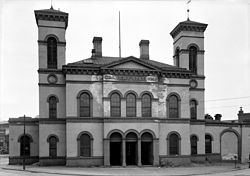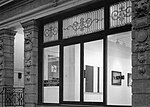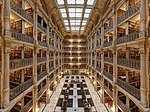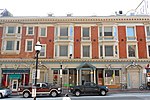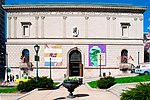Walters Art Museum is a public art museum located in the Mount Vernon section of Baltimore, Maryland. Founded and opened in 1934, it holds collections from the mid-19th century that were amassed substantially by major American art and sculpture collectors, including William Thompson Walters and his son Henry Walters. William Walters began collecting when he moved to Paris as a nominal Confederate loyalist at the outbreak of the American Civil War in 1861, and Henry Walters refined the collection and made arrangements for the construction what ultimately was Walters Art Museum.
After allowing the Baltimore public to occasionally view his father's and his growing added collections at his West Mount Vernon Place mansion during the late 1800s, Henry Walters arranged for an elaborate stone palazzo-styled structure to be built for this purpose in 1905–1909, located a block south of the Walters mansion on West Monument Street/Mount Vernon Place, on the northwest corner of North Charles Street at West Centre Street.
The mansion and gallery were also just south and west of the landmark Washington Monument in the Mount Vernon-Belvedere neighborhood, just north of the downtown business district and northeast of Cathedral Hill. Upon his 1931 death, Henry Walters bequeathed the entire collection of then more than 22,000 works, the original Charles Street Gallery building, and his adjacent townhouse/mansion just across the alley to the north on West Mount Vernon Place to the City of Baltimore, "for the benefit of the public." The collection includes masterworks of ancient Egypt, Greek sculpture and Roman sarcophagi, medieval ivories, illuminated manuscripts, Renaissance bronzes, Old Master European and 19th-century paintings, Chinese ceramics and bronzes, Art Deco jewelry, and ancient Near East, Mesopotamian, or ancient Middle East items. Dorothy Miner became its first Keeper of Manuscripts in 1934 and held the post until her death in 1973.
In 2000, "The Walters Art Gallery" changed its long-time name to "The Walters Art Museum" to reflect its image as a large public institution and eliminate confusion among some of the increasing out-of-state visitors. The following year, "The Walters" (as it is often known locally) reopened its original main building after a dramatic three-year physical renovation and replacement of internal utilities and infrastructure. The Archimedes Palimpsest was on loan to the Walters Art Museum from a private collector for conservation and spectral imaging studies.
Starting on October 1, 2006, the museum was enabled to make admission free to all, year-round, as a result of substantial grants given by Baltimore City and the surrounding suburban Baltimore County arts agencies and authorities. In 2012, "The Walters" released nearly 20,000 of its own images of its collections on a Creative Commons license, and collaborated in their upload to the world-wide web and the Internet on Wikimedia Commons. This was one of the largest and most comprehensive such releases made by any museum.

